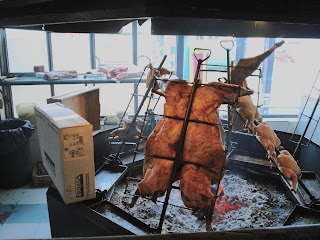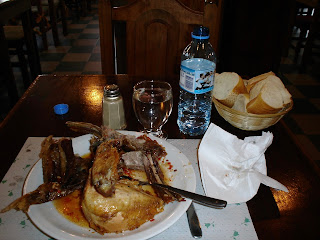Ushuaia, Argentina; It seemed I was the only long term resident at Los Cormoranes. People checked in, stayed overnight and left; musical beds with one stranger sleeping late in the bed next to me and a different stranger sleeping there when I came in at night. Tobacco addicts seem to be the norm in South America but the hostel was proactive with ‘No Fumar’, no smoking signs in all the rooms. They smoked in the office, study, lounge and kitchen but made good not to smoke in sleeping areas. I came in to find a new, old guy sitting on the bed across from me, shuffling through his belongings, a cigarette hanging off his lip half smoked with a long ash that was about to fall. He gave me a half-glance but no acknowledgment, nothing to respond to. I waited long enough to sense he wasn’t going to engage and asked, “Conoces sobre no fumar?” His Spanish was worse than mine still I got the drift; he wasn’t smoking, the cigarette was. I went to the office and complained to the older sister who was working the desk. She shrugged and said she would talk to him but she kept on with what she was doing. I asked, “When?” She shrugged again and said, “When I see him.” I went back to the room, propped the door open and raised both windows. He took his shaving kit and went to the bathroom. If I had to guess, I’d guess Easter European, maybe Czech or Romanian. He didn’t smoke again until the next morning and was going out the door when I woke up. He looked like a bad guy in a Liam Neeson movie; never saw him again.
I practiced guitar for about an hour after breakfast. When I told Martín I had it with me I asked, should I bring it? He said, by all means; there would be enough guitars to go around. Ushuaia is stretched out from east to west along the shore line. The business district is on the east end, near the prison museum and the waterfront. Farther west, the barrio unravels several miles with the international airport on a headland that juts out into the channel. I walked down to San Martin Ave., took a taxi from there. The address on the slip read like a coded encryption with names and numbers in a seemingly random array but I figured, “When in Rome . . .” The driver looked at it and told me, “No problema.”
The road leading out to the airport was good and the neighborhoods were similar to those I had walked. Then we lost the sidewalk on one side, the street narrowed and we turned one way or the other at every intersection. Pavement gave way to gravel and the sidewalk disappeared altogether, houses were only an arms reach from the car; just enough space for two small cars to pass. There were no street signs, no numbers on houses, no place to park. It felt like we were on a movie set. We stopped; “Estamos aqui.” he said. We are here. He gestured with his head to the small, low roof, yellow house on our left. With my guitar case over my shoulder I knocked on the door. It was 12:00.
Martín answered the door, ushered me in, introduced me to his parents Miguel and Graciela. With Martín to smooth out translations we juggled two languages easily. For nearly three hours we talked about life, family, our values and certainly music. The charango came out and he walked me through some chord progressions. They strum it very fast with the finger tips. With the Latin rumba and flamenco style the Nashville 1-4-5 progressions doesn’t apply and I was lost. The instrument comes from Bolivia, popular with native, pan flute bands. My Larrivee parlor guitar was loved at first sight. They play gut strings on everything and the metallic steel ping from my Canadian guitar really lit them up. They passed it around, playing rumba rhythms. When it made it back to me it was understood, they wanted to hear my music. I played some blues riffs; they smiled and nodded at the walks and the turn-arounds. I played and sang “St. James Infirmary Blues”. I think enthusiasm is really hard to fake and their reaction was enthusiastic. Every so often a big jet would roar overhead and we would wait for it to fade away. I wondered if it woke them at night but I didn’t ask. Benjamin arrived with his guitar. He was a year out of high school, working but wanting something better. He was quiet and shy while Martín was confident and outgoing. I showed them the Nashville number system for playing any song in any key. Martín picked up on it but Miguel thought it only interesting.
We nibbled cookies and cake, sipped coffee. Miguel had been a musician/music teacher all of his life. He was 4th generation from Germany, family migrated in the late 1800’s. We were in sync on politics and religion; we didn’t like either one and obviously, we identified with los pobres, the poor. Martín’s daughter was there, a stunning 4 year-old. It occurred to me that he might be alienated from his wife and this was his day with Gabriella. It would certainly fit the culture. Graciela might have been sitting for her granddaughter, like so many do. In any case, the family was happy together and they made me feel at home.
We sat around a table in the main room. A sofa against the wall would double as a bed. Three rooms with a bath, small by any standard but they made it nice. I thought about how much money I blow through, making believe I’m tight with a dollar and how los pobres have to make every peso return something valuable. They were not poor-poor but their means were sparse. Before time to go, Miguel gave me a flyer for a gig he had coming up. He and another guitarist were doing a two man show on the weekend. He said he would save me a table at the front. When my taxi pulled up we had just finished writing a blues song in Spanish. Getting the timing was clumsy at first but it was fun and the blues resonate in any language. “No my baby she don’t love me, leaves me feelin’ oh so bad.” It was a great way to finish a great afternoon. Back at Los Cormoranes I had the room to myself; took a long, hot shower and trimmed my whiskers.













